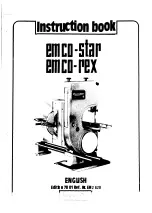
1
i
I
l
- 8 -
When the suw blade has been correctly adjusted, the nut is tightened up firmly using the box
spanner while the spindle is held by the locking pin. For grooving, the projection of the saw blade
above the table should be e9ual to the desired depth of groove. The groove width will be correct
M 60.02-03
\
Sketch 12
if it is about one-third the width of the wood. Sketch 12
shows the component and the ripping fence. The bearing sur
face of the fence has been extended by fitting an additional
strip to it.
A medium-pitch saw blade should be used for grooving on the
circular saw.
MAKI NG A COMBED JOINT:
The circular saw should be set up as a wobble saw. The combing
attachment is fitted to the saw table. The combing bar is
secured to the table by two clamping dogs and two
knurled bolts (Photo KS 10). The slotted holes in the
'' 9
clamping dogs enable the clearance between the saw
DIN i.Gi. M6•20
blade and the combing bar to be adjusted.
Combing is carried out as fol lows:
The height of the circurlar saw table is adjusted by
means of the handwheel until the projection of the
saw blade corresponds exactly to the thickness of the
boards being combed.
The component is then slowly pushed against the
circular saw while it is held against the mitre fence
and its edge runs along the combing bar (Photo KS 11).
After the component has been returned to its initial
position, i t is moved over to the right, so that the groove that has just been cut bears against the
combing bar (see Sketch 13). The second groove is then cut. The work described should first be per
formed on two short sample pieces of wood. An attempt should then be made to fit these two pieces
together. If the grooves are too wide, so that there is too much play in the joint, the combing bar
should be moved away from the saw blade by an amount equal to the play. If the grooves are too
narrow, so that the pins wil I not enter into the grooves, the combing bar is moved closer to the saw
blade which reduces the width of the pins.
When the combing bar has been adjusted a further set of grooves is cut in the sample pieces of wood
and checked.
Not until the combed joint made in the sample pieces fits perfectly should a start be made on machin
ing the actual components. When the grooves have been cut in the first board, reverse it, and hold
it with the first groove against the combing bar; the second board is then held against the edge of
MG0.02-03
the first and fed into the circular saw by means of the
,s,o
mitre fence. In this way, the second board is displaced
by the width of one groove. In other words, where
the first board has a pin, the second board will have
a groove, and the two wi II then fit together with
flush edges.












































